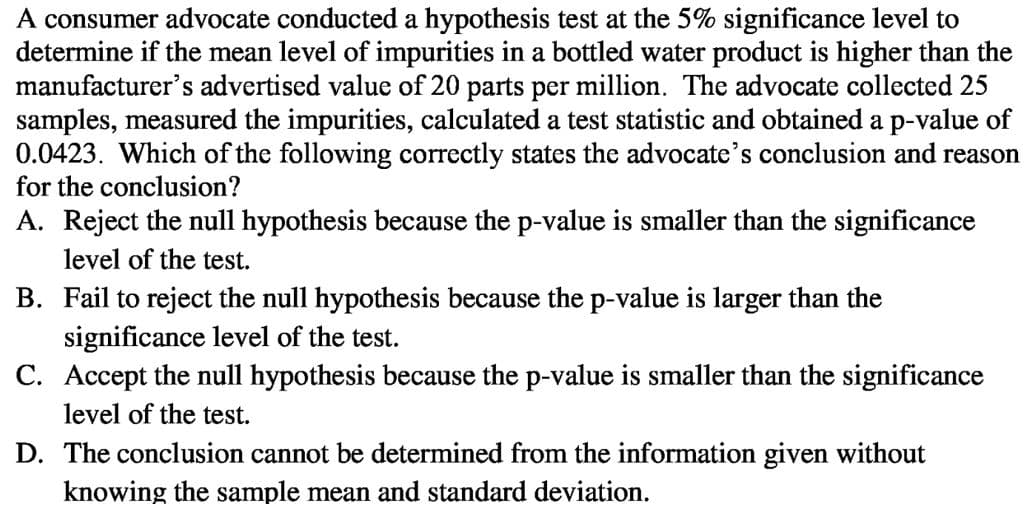A consumer advocate conducted a hypothesis test at the 5% significance level to determine if the mean level of impurities in a bottled water product is higher than the manufacturer's advertised value of 20 parts per million. The advocate collected 25 samples, measured the impurities, calculated a test statistic and obtained a p-value of 0.0423. Which of the following correctly states the advocate's conclusion and reason for the conclusion? A. Reject the null hypothesis because the p-value is smaller than the significance level of the test. B. Fail to reject the null hypothesis because the p-value is larger than the significance level of the test. C. Accept the null hypothesis because the p-value is smaller than the significance level of the test. D. The conclusion cannot be determined from the information given without knowing the sample mean and standard deviation.
A consumer advocate conducted a hypothesis test at the 5% significance level to determine if the mean level of impurities in a bottled water product is higher than the manufacturer's advertised value of 20 parts per million. The advocate collected 25 samples, measured the impurities, calculated a test statistic and obtained a p-value of 0.0423. Which of the following correctly states the advocate's conclusion and reason for the conclusion? A. Reject the null hypothesis because the p-value is smaller than the significance level of the test. B. Fail to reject the null hypothesis because the p-value is larger than the significance level of the test. C. Accept the null hypothesis because the p-value is smaller than the significance level of the test. D. The conclusion cannot be determined from the information given without knowing the sample mean and standard deviation.
A First Course in Probability (10th Edition)
10th Edition
ISBN:9780134753119
Author:Sheldon Ross
Publisher:Sheldon Ross
Chapter1: Combinatorial Analysis
Section: Chapter Questions
Problem 1.1P: a. How many different 7-place license plates are possible if the first 2 places are for letters and...
Related questions
Topic Video
Question

Transcribed Image Text:A consumer advocate conducted a hypothesis test at the 5% significance level to
determine if the mean level of impurities in a bottled water product is higher than the
manufacturer's advertised value of 20 parts per million. The advocate collected 25
samples, measured the impurities, calculated a test statistic and obtained a p-value of
0.0423. Which of the following correctly states the advocate's conclusion and reason
for the conclusion?
A. Reject the null hypothesis because the p-value is smaller than the significance
level of the test.
B. Fail to reject the null hypothesis because the p-value is larger than the
significance level of the test.
C. Accept the null hypothesis because the p-value is smaller than the significance
level of the test.
D. The conclusion cannot be determined from the information given without
knowing the sample mean and standard deviation.
Expert Solution
This question has been solved!
Explore an expertly crafted, step-by-step solution for a thorough understanding of key concepts.
This is a popular solution!
Trending now
This is a popular solution!
Step by step
Solved in 2 steps with 2 images

Knowledge Booster
Learn more about
Need a deep-dive on the concept behind this application? Look no further. Learn more about this topic, probability and related others by exploring similar questions and additional content below.Recommended textbooks for you

A First Course in Probability (10th Edition)
Probability
ISBN:
9780134753119
Author:
Sheldon Ross
Publisher:
PEARSON


A First Course in Probability (10th Edition)
Probability
ISBN:
9780134753119
Author:
Sheldon Ross
Publisher:
PEARSON
